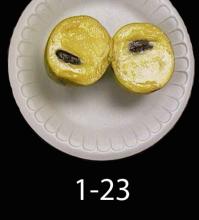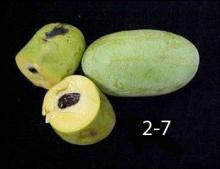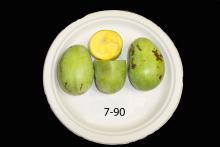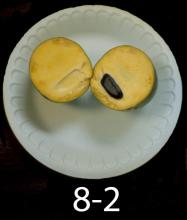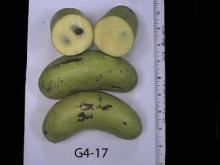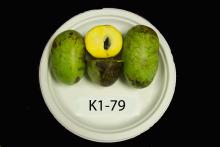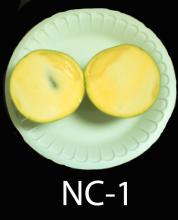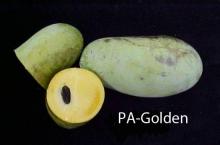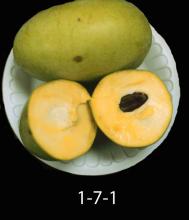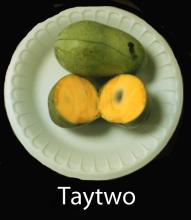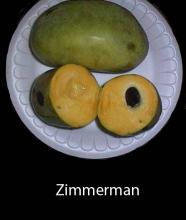Maturity and Quality
Pawpaw (Asimina triloba; family Annonaceace) is the largest edible fruit native to the eastern U.S. The fruit ripens between mid August and mid October, depending on genotypes and growing location.
The only way to detect if ripening has commenced is to gently press or squeeze the fruit to determine if softening is evident. Some cultivars exhibit a change in skin color from darker to lighter green or even to yellow, and some also exhibit some skin browning or darkening at more advanced stages of ripening. Flesh may be cream-colored, yellow, or light orange, depending on cultivar, when fully ripe. Ripening is accompanied by an increase in soluble solids including sugars (sweetness) and significant aroma production. Pawpaws should be picked when flesh softening is first evident, as they ripen rapidly and become too soft to handle within 3 to 5 days.
- Green to yellowish-green skin, firm fruits with minimal brown discoloration on the skin.
- Soft, custard-like flesh
- Sweetness (glucose, fructose and sucrose) at >18-20% soluble solids
- Intense aroma reminiscent of banana, mango, and/or pineapple.
- Free of bruises and decay
Postharvest Handling and Storage
0-4°C (32-40°F) for a maximum of 4 weeks
Lower temperatures within this range and especially longer periods of cold storage may induce chilling injury.
Respiration at harvest may be 50-100 mg CO2/ kg•hr at 20°C (68°F), and may increase 2- to 5-fold to a peak within 3 days.
Field and laboratory studies to date using chemicals, atmospheric modification, or heat treatments that have been effective at modifying ripening behavior in many climacteric species via effects on ethylene biosynthesis or action have failed to appreciably alter ripening of pawpaw.
90-95%
Ethylene production at harvest may be 1-4 µg/kg•hr at 20°C (68°F), and it may increase to 5-15 µg/kg•hr within 3 days.
Pawpaw exhibits increasing respiration and ethylene production with peak values within 3 days after harvest indicating it is a climacteric fruit.
There is no information on their response to CA storage.
Temperature & Controlled Atmosphere Photos
Disorders
Chilling Injury. Both skin and internal flesh browning of pawpaw have been observed by 6 weeks at 0-4°C (32-40°F).
Physical Injury. Similar to wound-induced browning in banana, pawpaws can be bruised during ripening. Thus, gentle handling to minimize bruising is essential to reducing postharvest losses.
Shriveling. Symptoms become visible by 6 weeks of cold storage.
Postharvest diseases of pawpaws from Cladosporium spp. and Fusarium spp. have been observed by 6 weeks of 0-4°C (32-40°F) storage.



